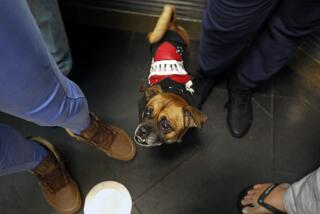When a Pet Is in Trouble, It’s Time for Mouth to Snout CPR
- Share via
In a basement room behind closed doors in Van Nuys, nine people sat around a long table. In front of each was a cute, plush animal toy.
Suddenly, on a signal from the man at the head of the table, a woman firmly grabbed her toy doggie, placed her mouth directly over the little furry mouth and blew hard. “Good!” called out the head man.
*
This was not a meeting of some bizarre cult. They were Red Cross instructors learning emergency pet first aid, including cardiopulmonary resuscitation, mouth-to-mouth resuscitation and the Heimlich maneuver. The field is a growing one, according to instructor Charles James, and Los Angeles is on the cutting edge.
“We are getting calls from all over the country,” said James. “People love their animals. They don’t want to stand by helplessly if something happens to them.”
But mouth-to-mouth resuscitation? On a dog?
“Actually,” corrected student paramedic Robbie Cowen, “it’s mouth-to-snout.” And he should know--although he wasn’t in the Red Cross class, he has had firsthand experience.
Last month, Cowen, 19, who lives in Agoura Hills, saved the life of his Dalmatian, Abby, after the dog swallowed a little rubber ball. Cowen’s father managed to get the ball out, but Abby had stopped breathing.
“I put my mouth on her snout and blew in until I could see her rib cage expand,” Cowen said.
After about five minutes, Abby started to breathe on her own. Cowen expressed no regrets, even though he has had to put up with plenty of “Ewwwwww, gross” comments from friends.
Would he do it again if his dog stopped breathing?
“In a heartbeat,” Cowen said, pulling Abby close for a hug.
His sentiments are not universal.
“I got a call from one Red Cross chapter,” James said. “The man said, ‘Out here, we call a dog who needs mouth-to-mouth resuscitation a dead dog.’ ”
James, a former lifeguard who has been a Red Cross employee for 15 years, has no animals at home. “I have plastic fish in my aquarium,” he said. “That way, they don’t tend to die on me.”
He began teaching pet first-aid classes for the organization about a year ago.
“We were noticing that during a lot of disasters, like the earthquake, people were bringing their pets with them to the shelters,” James said. “They didn’t know what to do if the animals had a cut or a broken bone.
“This seemed like a natural for us.”
The next pet first aid course will be held July 24 at American Red Cross Headquarters, 2700 Wilshire Blvd.
A few Red Cross chapters on the East Coast were also holding pet first-aid classes, and this year the organization put out its first book-length guide on the subject.
In the Los Angeles area, interest in classes grew to the point that in the last few months, James began training other teachers.
Before getting to CPR in this instructors’ class, several other topics were covered--approaching an injured animal, caring for burns, taking a cat’s temperature (don’t ask) and making splints for broken bones.
But the highlight of the evening was the hands-on CPR, including “rescue breathing.”
One of the participants, Carol Young, who teaches first aid in Covina, said doggie CPR harks back to the mid-1960s, when she first learned the procedure.
“Back then, we learned CPR on live dogs, usually German shepherds or Labs,” Young said. “They were anesthetized, and their paws were taped down on a board so they were on their backs. They were defibrillated to give them an irregular heartbeat, which we would try to make regular.”
The dogs did not always survive the class.
“It was horrible, it was awful,” Young said. “Our dog made it, but some others didn’t. We were all very upset.”
*
All the training at this class was done on stuffed animals James picked up in bulk at a toy store, and also on a realistic-looking doggie dummy made especially for CPR simulations.
The fake dog--which cost the Red Cross about $800, according to James--had a button on its left side to indicate “this side up” for CPR. James taught the students where to feel on the rear leg for a pulse (he simulated the heartbeat with the use of a squeeze bulb attached to the dummy for that purpose) and where to apply pressure to revive breathing.
The procedure is similar to that used on humans, including mouth-to-mouth. James suggests using a little face shield--also available from the Red Cross--to avoid direct mouth contact.
“You never know where a dog’s mouth and nose has been,” he said.
This didn’t faze one of the students, Jessie Carrillo, 25, of Pasadena, who has three dogs at home. “I would prefer to do mouth-to-mouth on an animal than a human,” he said. “A dog’s mouth is probably a lot cleaner.”
Not everyone in the class was quite as willing.
“I don’t have pets at home, but I thought this would be interesting,” said Carol Dewey, who teaches Red Cross courses in Burbank.
But would she be willing to do rescue breathing on a live dog?
“That’s why I’m an instructor,” she said with a smile.
“Others will be doing that.”
More to Read
Sign up for Essential California
The most important California stories and recommendations in your inbox every morning.
You may occasionally receive promotional content from the Los Angeles Times.














![Vista, California-Apri 2, 2025-Hours after undergoing dental surgery a 9-year-old girl was found unresponsive in her home, officials are investigating what caused her death. On March 18, Silvanna Moreno was placed under anesthesia for a dental surgery at Dreamtime Dentistry, a dental facility that "strive[s] to be the premier office for sedation dentistry in Vitsa, CA. (Google Maps)](https://ca-times.brightspotcdn.com/dims4/default/07a58b2/2147483647/strip/true/crop/2016x1344+29+0/resize/840x560!/quality/75/?url=https%3A%2F%2Fcalifornia-times-brightspot.s3.amazonaws.com%2F78%2Ffd%2F9bbf9b62489fa209f9c67df2e472%2Fla-me-dreamtime-dentist-01.jpg)